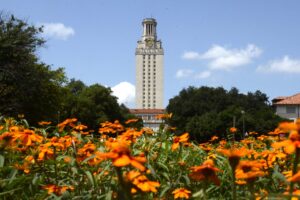AUSTIN, Texas—University of Texas at Austin astronomer Karl Gebhardt and colleagues have discovered the first black holes lurking in the hearts of two giant clusters of stars. The research provides clues to how the much-heavier “supermassive” black holes, which exist at the centers of galaxies like our Milky Way, formed.
A black hole is an infinitely dense region of space, with such high gravity that not even light can escape. For many years, astronomers have known two types — supermassive black holes at the centers of large galaxies and the so-called “stellar-mass” black holes that result when a star about 10 times the Sun’s mass ends its life in a supernova explosion. Both types have been detected and measured, Gebhardt said, but a black hole with a mass in between these two has not been detected before.
Gebhardt, Michael Rich of UCLA and Luis Ho of the Carnegie Institution of Washington recently used the Earth-orbiting Hubble Space Telescope (HST) to spy on G1, a so-called “globular star cluster” in the nearby Andromeda galaxy. Globular clusters are spherical conglomerations of hundreds of thousands to millions of stars. (In contrast, a galaxy like our Milky Way contains about 200 billion stars.)
The team measured the speeds of the stars near the center of the cluster. The faster the stars move, the heavier the object they’re orbiting has to be. They deduced that G1’s central object weighs 20,000 times more than our Sun. This means it must be a black hole.
Gebhardt is also working with another group, including Roeland van der Marel of the Space Telescope Science Institute in Baltimore and others, who similarly studied the globular M15 in our own Milky Way galaxy with HST. They found that M15 harbors a black hole about 4,000 times the Sun’s mass.
“The black holes in G1 and M15 have masses in between stellar-mass and supermassive black holes,” Gebhardt said. “They provide an important link that may hold the clue to how supermassive black holes form in galaxies.”
Astronomers studying nearby galaxies have discovered a relationship between the size of a galaxy and the mass of the black hole at its heart: The bigger the galaxy, the more massive the black hole. Unfortunately, there are not enough small galaxies nearby to test the relationship at that end of the scale. Gebhardt said that globular star clusters are a good substitute for small galaxies. And the masses of the black holes in G1 and M15 fall in line with the black hole mass/galaxy mass relationship demonstrated in the past by Gebhardt and others.
“This evidence has major consequences about how we think black holes formed in galaxies,” Gebhardt said. “Galaxies form out of a large collapsing cloud of gas. And the first things to form in that cloud are globular clusters. Those globulars are very stable, and very likely contained black holes in them at the time of their formation.
“There are two main theories about how galactic black holes form,” Gebhardt said. “You could either make the black hole all at once, when the galaxy is forming, by dumping a lot of material in the middle, or you could start with a seed black hole that subsequently grows over time. The observational evidence now points to the idea that you start out with a small seed black hole.”
The fact that globular clusters have these small black holes implies that they are excellent candidates to act as the seeds for the supermassive black holes that lurk in the centers of nearly all galaxies.
The G1 research will be published in an upcoming issue of The Astrophysical Journal Letters. The M15 research will be published in two articles in an upcoming issue of The Astronomical Journal.
Gebhardt is studying other globular clusters, looking for more black holes. He will also do follow-up studies of G1 and M15 at The University of Texas at Austin’s McDonald Observatory near Fort Davis.
Karl Gebhardt is an assistant professor in the university’s Department of Astronomy. He may be reached at 512-471-1473.
Note: For links to high-resolution images, visit the McDonald Observatory Web site.
For more information contact: Rebecca Johnson, McDonald Observatory, 512-475-6763.



